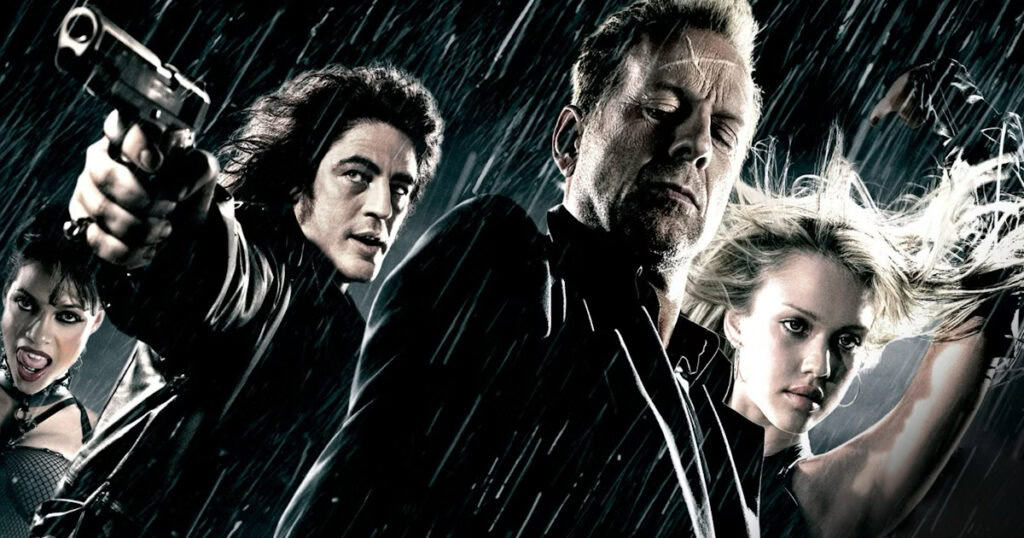We take a look at Robert Rodriguez’s acclaimed adaptation of Frank Miller’s classic Sin City.
In today’s episode of WTF Happened to this Movie, we’re going to take a retrospective look at the revolutionary film Sin City. We’ll talk a bit about the highs and some lows, the stacked cast of Hollywood alumni, and, of course, the efforts made behind the camera to create this pop-culture cinematic staple. Let’s begin…
Director Robert Rodriguez has had his share of hits and misses over his multi-decade-long career. To think that the director of Shark Boy and Lava Girl is the same visionary filmmaker that brought us The Mexico Trilogy and Alita Battle Angel is somewhat of a strange thought, but then again, when you own your own studio as a true independent filmmaker- you can pretty much make whatever you want.
Lucky for us, in 2005, Rodriguez and Frank Miller joined forces to adapt Miller’s masterpiece graphic novel series Sin City into a theatrical film. Fans of the Sin City books are aware of Miller’s unique semi-monochromatic panels with only a few bold pops of color for certain scenes and images. And much like Zach Snyder’s 300, Rodriguez set out to deliver a movie that would be a direct visual translation of the original artwork. As you can imagine, this was going to be a daunting task that would require mass amounts of creativity, imagination, inspiration, and of course… money.
Between Dimension Films and Rodriguez’ own Troublemaker Studios- the film got a budget of $40M USD which was considered cheap for a comic book fim, let alone a comic book film with this level of visual intrigue. But of course, the world of Sin City deserved its best shot at being brought to life, so Rodriguez called on Frank Miller from the very beginning to co-direct the project and act as a level of quality control. After all, according to Robert Rodriguez, when discussing the making of the movie:
“ It’s less of an adaptation and more of a translation”
Ya see, from the beginning- this movie’s goal was to take the darkly noir imagery from the Miller books and put A-list actors in the place of the characters to read the words exactly as they were written. And, how did it go?

Sin City is the kind of movie that, since its release in 2005, has been imitated but never successfully duplicated. Despite receiving a sequel nearly a decade later, this movie and Rodriquez’ intense grindhouse noir style seem to have caught lightning in a bottle regarding the magic of Sin City. Containing an all-star lineup of actors ranging from personal friends and collaborators like Elijah Wood, Josh Hartnett, and Carla Gugino- to other recognizable stars like Mickey Rourke, Bruce Willis, Jessica Alba, and Clive Owens. The film is an anthology that catalogues the life and times of some of Sin City’s underbelly residents. This includes adaptations of The Yellow Bastard, where Bruce Willis plays a nearly retired detective who embarks on an 8-year mission to rescue Nancy (Jessica Alba) from the clutches of a serial rapist and murderer. Then, The Customer is Always Right, a quick one that showcases what’s essentially two scenes of Josh Hartnett doing his thing. Then, my personal favorite, The Hard Goodbye, in which Mickey Rourke plays Marv, a rough street brawler with brain damage who wakes up next to a friendly escort to find that she’s been murdered. He then scraps and kills his way up the chain of crime until he avenges the murder of his only friend. It’s a tragic ending for this one, by the way- but that’s the case for pretty much all of these. All except for the final story, The Hard Goodbye. This one features yet another trip into Sin City to follow a local tough guy who both starts and ends a war between the police, the mob, and a neighbourhood full of prostitutes that, trust me, fellas, you do NOT want to f*ck with.
These stories all have the same visual style, as well as the same noir writing style that calls back to 1950s detective stories. Since the movie wouldn’t be deviating from the original source material, the actors had their work cut for them in terms of learning their lines- but the incredible amount of augmentation done to some of the film’s more memorable characters like Marv and, of course, the yellow bastard himself. Rodriguez and Troublemaker Studios always seem to be at the forefront of technology when it comes to what’s possible for filmmakers on a budget. And when it comes to things like makeup and effects, what better way to pinch those pennies than to make it all in-house? Troublemaker Studios in Austin, TX, is an incredible workshop/film studio/film set. I’ve actually toured this place and taken selfies with some of the costumes worn in this movie. Mickey Rourke’s facial prosthetics and wig rendered the man nearly unrecognizable if not for that wonderful gruff voice.
As far as the impact this movie had on cinema, the box office lit up with excitement and cold hard cash reaching over $150M on a budget of just 1/3 of that. Miller and Rodriguez had a certified hit. The film would receive praise from general audiences who found the bizarre style of the film to be refreshing from other comic book fare, while also providing a detailed and visually pleasing world to get sucked into for these twisted tales. And of course, fans of the books who eagerly awaited this release also seemed to really enjoy it- which helped to propel the film to a highly successful physical release. Shortly proceeding this film, we’d see the rise of certain imitators like the dreadful Max Payne starring Mark Wahlberg, and even Frank Miller’s The Spirit which makes similar attempts to capture the style but without Rodriguez to really bring it home.
For the most part, this movie holds up well as a slice of movie history that stands out from others of its kind. It sports one of the greatest casts in a comic book film (or any film for that matter), it pays homage to gritty noir thrillers while delivering on all the blood and guts you want from a grindhouse outing, and above all- it’s an extension of something that was created out of passion by one of the greatest minds in comic book history. It was a risk to make, and specifically a risk to make in the way they did. But if you ask me, this one was special and remains important. And that’s what happened to Sin City.
Originally published at https://www.joblo.com/wtf-happened-to-sin-city/




